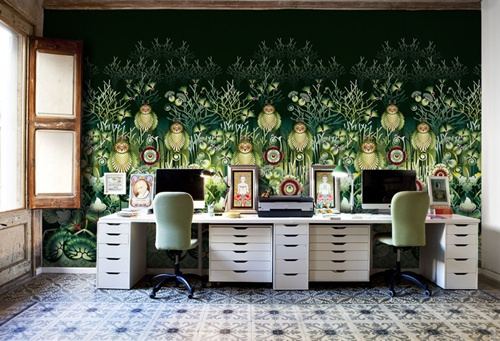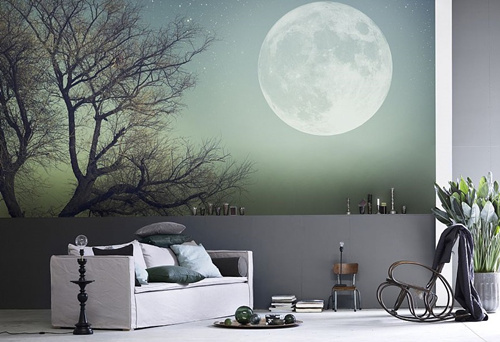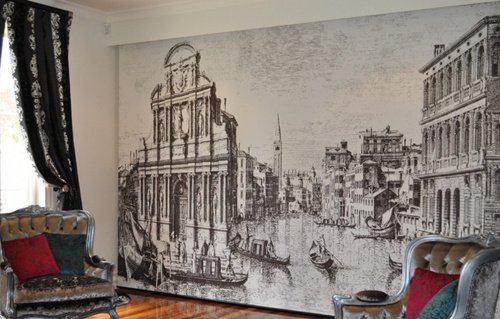Best Instructions for "How to Paint a Wall Mural?":
A wall mural is any piece of artwork painted or applied directly on a wall, ceiling or other large permanent surface. A distinguishing characteristic of mural wall painting is that the architectural elements of the given space are harmoniously incorporated into the picture.
Some wall mural paintings are painted on large canvases, which are then attached to the wall (e.g., with marouflage). Whether these works can be accurately called "murals" is a subject of some controversy in the art world, but the technique has been in common use since the late 19th century.

In the history of mural painting several methods have been used:
A fresco painting, from the Italian word affresco which derives from the adjective fresh, describes a method in which the paint is applied on plaster on walls or ceilings. The buon fresco technique consists of painting in pigment mixed with water on a thin layer of wet, fresh, lime mortar or plaster. The pigment is then absorbed by the wet plaster; after a number of hours, the plaster dries and reacts with the air: it is this chemical reaction which fixes the pigment particles in the plaster. After this the painting stays for a long time up to centuries in fresh and brilliant colors.
Fresco-secco painting is done on dry plaster. The pigments thus require a binding medium, such as egg, glue or oil to attach the pigment to the wall.
Mezzo-fresco is painted on nearly-dry plaster, and was defined by the sixteenth-century author Ignazio Pozzo as "firm enough not to take a thumb-print" so that the pigment only penetrates slightly into the plaster. By the end of the sixteenth century this had largely displaced the buon fresco method, and was used by painters such as Gianbattista Tiepolo or Michelangelo. This technique had, in reduced form, the advantages of a secco work. (Traditional Wall Painting Techniques)

Modern wall mural painting techniques:
Different muralists tend to become experts in their preferred medium and application, whether that be oil paints, emulsion or acrylic paints applied by brush, roller or airbrush/aerosols. Clients will often ask for a particular style and the artist may adjust to the appropriate technique.
A consultation usually leads to a detailed design and layout of the proposed mural with a price quote that the client approves before the muralist starts on the work. The area to be painted can be gridded to match the design allowing the image to be scaled accurately step by step. In some cases the design is projected straight onto the wall and traced with pencil before painting begins. Some muralists will paint directly without any prior sketching, preferring the spontaneous technique.
Once completed the mural can be given coats of varnish or protective acrylic glaze to protect the work from UV rays and surface damage.
CAM designed Frescography by Rainer Maria Latzke, digitally printed on canvas
As an alternative to a hand-painted or airbrushed mural, digitally printed murals can also be applied to surfaces. Already existing murals can be photographed and then be reproduced in near-to-original quality.
The disadvantages of pre-fabricated murals and decals are that they are often mass-produced and lack the allure and exclusivity of an original artwork. They are often not fitted to the individual wall sizes of the client and their personal ideas or wishes can not be added to the mural as it progresses. The Frescography technique, a digital manufacturing method (CAM) invented by Rainer Maria Latzke addresses some of the personalisation and size restrictions.
Digital techniques are commonly used in advertisements. A "wallscape" is a large advertisement on or attached to the outside wall of a building. Wallscapes can be painted directly on the wall as a mural, or printed on vinyl and securely attached to the wall in the manner of a billboard. Although not strictly classed as murals, large scale printed media are often referred to as such. Advertising murals were traditionally painted onto buildings and shops by sign-writers, later as large scale poster billboards. (Mordern Wall Painting Techniques)

The following is the detailed instructions on "how to paint a wall mural?"
No.1: Use an Overhead Projector to Transfer the Mural Painting Design
01) Select a design that you'd like to paint on your wall. The design can be one you've drawn yourself or one you've found on a greeting card, in a coloring book or from another source.
02) Make a color copy of the image you have selected to use as a reference when you're painting.
03) Make a black-and-white photocopy of the image. Use the copy machine to enlarge the image to a size at which you can easily see all the details.
04) Make a black-and-white transparency of your design. Ask the clerk at the copy store to help you.
05) Place the transparency on an overhead projector.
06) Turn the projector on and project the design onto the desired wall area.
07) Move the projector closer to or farther from the wall until the design is positioned correctly and is the desired size.
08) Mark the position of the projector on the floor with masking tape in case you need to move the projector before you've finished transferring the design.
09) Outline the design on the wall carefully with a pencil.

No.:2: Use a Grid to Transfer the Mural Design
10) Select and prepare your mural painting design, following steps 1 through 3 above.
11) Draw a grid over the photocopy of your design and enlarge it onto a piece of butcher paper
12) Cut each image in the design out of the butcher paper with scissors, beginning with the largest.
13) Use masking tape to fasten the cut paper images to the wall in the desired location.
14) Trace around each paper image carefully with a pencil.
15) Cut out any shapes that are inside the large paper images: a butterfly's spots or windows on a bus, for example.
16) Tape these smaller shapes in the appropriate locations inside the larger outlines.
17) Trace around the smaller shapes with a pencil.
18) Sketch in additional details, referring to the photocopy of your design.
No.2 Painting the Mural Design
19) Select acrylic paint colors for your mural by referring to the color copy of your design.
20) Pour each paint color into a plastic container.
21) Use a wide, flat paintbrush to paint in the large areas of your design first.
22) Blend and shade colors by painting one color on top of another before the bottom color has had a chance to dry.
23) Use a round paintbrush to add details and outline images.
No.4: Helpfull tips and experiences:
Select a simple design with a limited number of colors if this is your first mural.
If you don't have access to an overhead projector, ask your friends. Teachers or others who do visual presentations at work may be able to borrow a projector for you to use.
If you're planning to paint your design with light colors, use a light-colored pencil to transfer it to the wall. Black pencil lines may show through.
You can draw the grid and enlarge your design directly on the wall surface if your mural design completely covers the wall area with paint.
Interior latex paint can be used for painting large areas of color.
Because acrylic paints tend to be slightly transparent, it may take more than one coat to get the desired tint.
Position the overhead projector squarely in front of the wall. If it's angled to one side or the other, it will distort the projected image.
Make sure the image you're using doesn't have a copyright. Copy stores will not allow you to photocopy copyrighted images. (Instruction for "How to paint a wall mural?", refer to EHOW)
Edited by Kevin from Xiamen Romandy Art Limited.
Founded in 2001, Xiamen Romandy Art Co., Ltd. is one of the leading oil painting galleries engaged in the production of handmade oil paintings in China. Our high quality products and excellence in service have helped us to enjoy a high reputation among our clients.
Tags: Best Instructions for "How to Paint a Wall Mural?" ,Wall Painting Techniques, Painting Techniques for Walls.
|